Performance & Battery Life Report: Xiaomi Redmi Note 4 with MediaTek Helio X20
by Matt Humrick on February 23, 2017 7:00 AM EST- Posted in
- Smartphones
- Mobile
- Xiaomi
- MediaTek
- Helio X20
- Redmi Note 4
CPU & System Performance
The Redmi Note 4 has two power settings: Performance and Balanced (default). Normally settings like these alter DVFS and/or scheduler behavior, giving the user a choice between better performance or longer battery life. On the Redmi Note 4, however, with the Chinese ROM I tested, these settings do nothing. Monitoring DVFS behavior under a variety of workloads revealed no discernible difference between the settings, which was confirmed by essentially identical scores in all of our performance tests.
The PCMark Work 2.0 suite evaluates overall system performance, testing the combined effects of the CPU, GPU, RAM, and NAND storage. Because it uses standard Android API calls and runs several different real-world workloads that elicit realistic behavior from the CPU governor (unlike synthetic tests that simply run one or more CPUs at max frequency), it’s a good indicator of everyday performance.
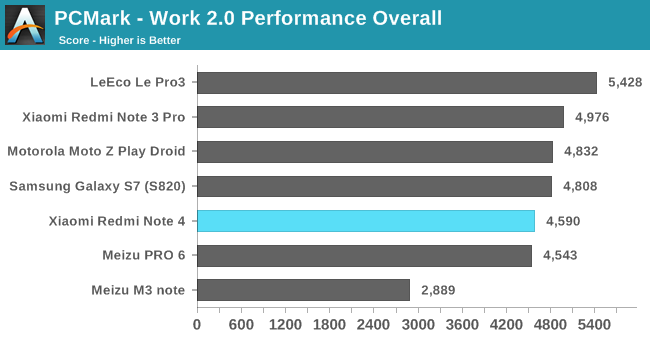
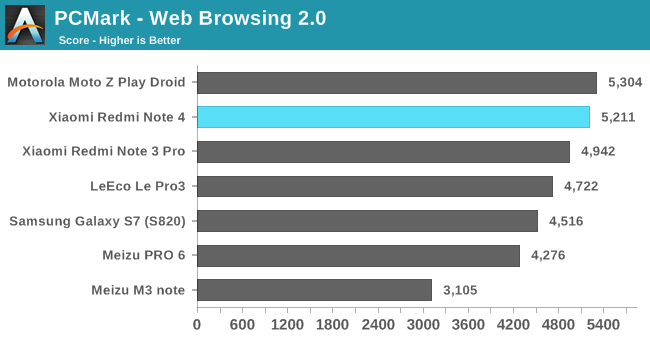
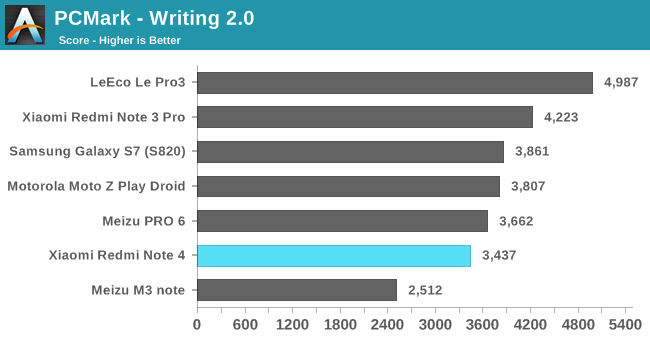

Looking at the overall results first, the Redmi Note 4 matches the performance of the Meizu Pro 6 and falls just shy of Samsung’s Galaxy S7 (Snapdragon 820) and Xiaomi’s Redmi Note 3 Pro, which is just 8% faster; however, looking at the individual subtest scores shows that larger differences exist between these phones.
In the Web Browsing test, the Redmi Note 4 performs quite well, outpacing the Meizu Pro 6 and its higher clocked Helio X25 by 22%. Despite the new load threshold values, it appears Meizu’s implementation is still a bit conservative considering the X25’s Max CPU cluster has a 20% peak frequency advantage over the X20 in the Redmi (the advantage for its Mid CPU cluster is 8.5%). The Redmi Note 4 also finishes ahead of both Snapdragon 820/821 phones as well as the older Redmi Note 3 Pro.
The finishing order in the Writing test, whose workload tends to migrate threads to the big CPU cores more often than the Web Browsing test, is quite different. Here we see the Meizu Pro 6 pull ahead of the Redmi Note 4 by a small 6.5% margin, which is more inline with expectations; however, the Redmi Note 3 Pro is 23% faster than the newer model in this test.
The Data Manipulation test, which measures how long it takes to parse data from several different file types and then records the frame rate while interacting with dynamic charts, jumbles up the results once again, demonstrating how diverse workloads can elicit different levels of performance that are affected more by the software parameters that govern scheduler and DVFS behavior than the speed of the underlying hardware.
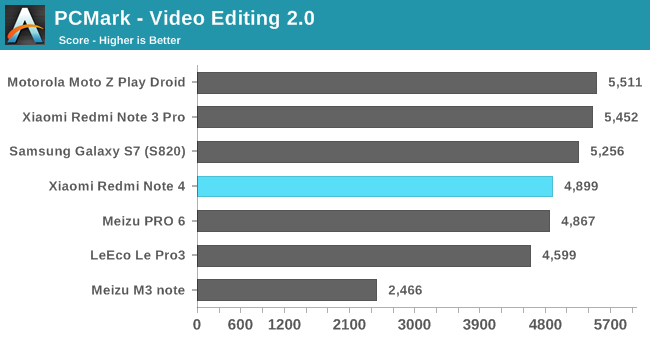

A significant portion of the Video and Photo Editing workloads utilizes GPU compute, so it’s no surprise that the Redmi Note 4 and Meizu Pro 6, which use the same GPU, show similar performance. The Photo Editing test is far more intense, resulting in a larger performance gap between the Galaxy S7 and LeEco Le Pro3, which use Snapdragon 820 and 821 SoCs, respectively, and the phones with lower-performing GPUs.
Since the Redmi Note 4 is still running Android 6, I was hoping to run DiscoMark to measure the time it takes to open and switch between several common apps (DiscoMark does not work with Android 7); unfortunately, Xiaomi’s MIUI kept interfering and would not reliably allow DiscoMark to open or switch apps via Android's accessibility services. I did not encounter this issue when testing older versions of the global ROM, so this is either a new “feature” or a behavior specific to the Chinese ROM.

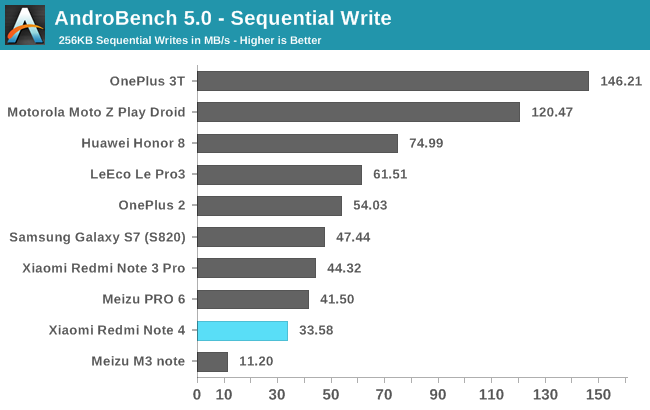
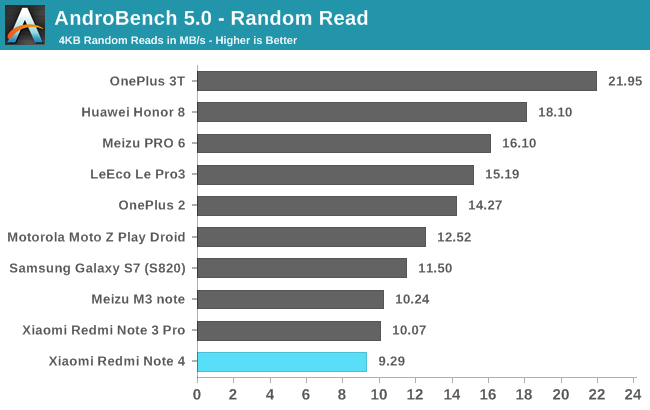
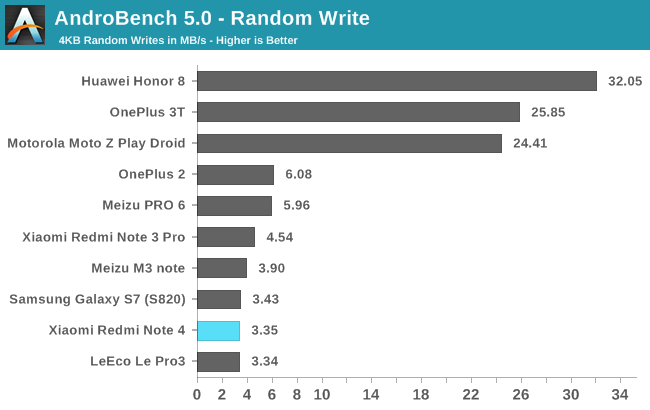
The Redmi Note 4’s internal storage performance is rather poor. Sequential reads fail to break the 100 MB/s mark—less than half the performance of the older Redmi Note 3 Pro—and its sequential write and random I/O performance are hardly any better. Thinking the results may be in error, I ran a different storage test on both Redmi phones that also measured sequential and random patterns for 4KB, 16KB, and 256KB I/O sizes, and while the margins were slightly different, the end result was the same: The Redmi Note 3 Pro outperformed the Redmi Note 4 in every test.
These results did not agree with my subjective experience while using the phone, however. For example, the Redmi Note 4 launches apps just as quick as the Redmi Note 3 Pro. Curious, I dug deeper by performing some local file copy tests. In the first test, I copied a 300MB file and the Redmi Note 3 Pro finished sooner but just barely. I then copied a much larger file, almost 1.4GB, and the Note 4 finished well ahead of the Note 3 Pro. Even copying 1,000 small ~2KB text files, the contents of which varied only slightly, proved faster with the Note 4.
| Sequential Storage Performance (AndroBench 5.0) | ||||||||
| Sequential Read (KB) | Sequential Write (KB) | |||||||
| 1024 | 2048 | 4096 | 8192 | 1024 | 2048 | 4096 | 8192 | |
| Redmi Note 4 | 99.98 | 129.62 | 141.12 | 178.60 | 55.41 | 81.51 | 103.62 | 118.33 |
| Redmi Note 3 Pro | 203.57 | 220.97 | 234.01 | 233.38 | 62.16 | 68.07 | 70.59 | 73.54 |
| % Difference | -50.9% | -41.3% | -39.7% | -23.5% | -10.9% | 19.7% | 46.8% | 60.9% |
The table above shows how the Note 4’s storage performance scales better than the Note 3 Pro’s for both sequential reads and writes with increasing I/O sizes. Most file operations outside reading and writing photos and video will not trigger such large chunks, but in certain cases, like the file copy examples above, the Linux page cache, which improves disk I/O by caching all file reads and writes in RAM, allows multiple small files to coalesce and be written to NAND in one larger chunk, effectively hiding the Note 4’s weakness with small I/O.
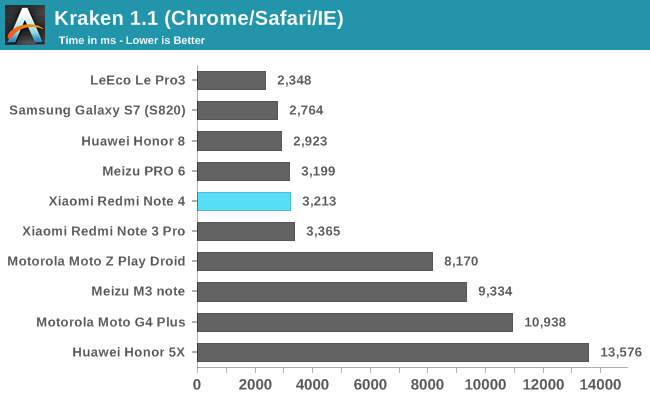
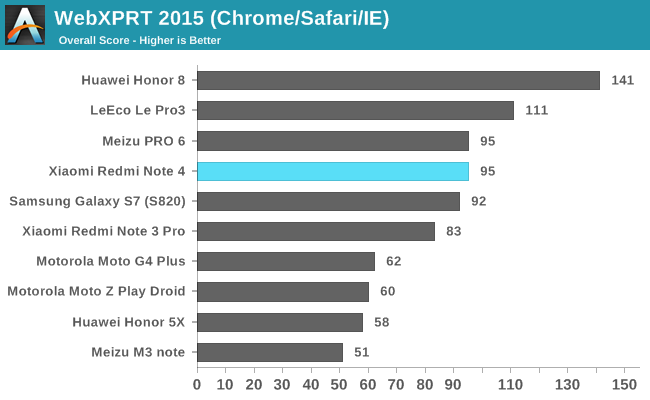
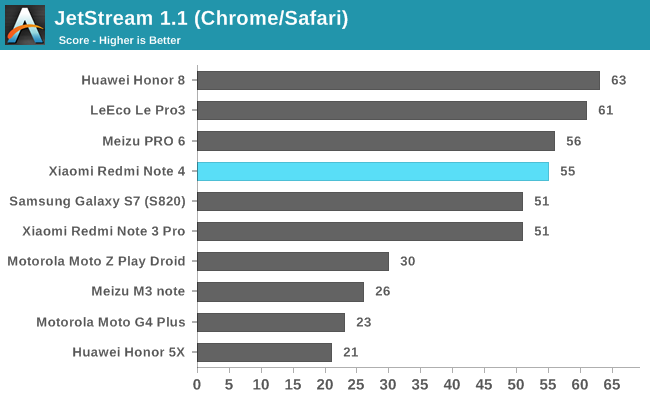
In all three JavaScript tests, the Helio X20 and X25 SoCs in the Redmi Note 4 and Meizu Pro 6, respectively, perform essentially the same. The Snapdragon 650 SoC in the Redmi Note 3 Pro has two A72 cores like both Helio SoCs, but they top out at 1.8GHz. Its four A53 cores (1.4GHz) are also slower than the Helio’s A53 Mid clusters, putting it at a disadvantage in these tests that are especially sensitive to CPU frequency. The Redmi Note 4 outperforms the older model in all three tests by 5% to 15%. The four devices with octa-core A53 CPU configurations fall to the bottom of the pack by a noticeable margin.
Overall Xiaomi’s Redmi Note 4 performs quite well. Just as we saw with the Redmi Note 3 Pro and its Snapdragon 650 SoC, the inclusion of two A72 CPU cores in the Note 4’s Helio X20 gives it a huge advantage over the octa-core A53 configurations prevalent at this price point. Its Web browsing performance is very good, it opens apps pretty quickly, and its user interface and scrolling performance is mostly fluid with only occasional hiccups. The speed of the onboard NAND when handling small I/O is disappointing, but it’s not really noticeable during normal use. Its modest GPU also falls behind when handling GPU compute workloads, increasingly found in photo and video editing apps.










34 Comments
View All Comments
leo_sk - Friday, February 24, 2017 - link
Maybe 625 was a good upgrade, 650 and 652 left only battery life as positive point. Had they been built at same process instead of 28nm, they would have dulled the battery advantage quite a bit too. But then, that would have left 820 with gpu advantage alone. I wonder why samsung or huawei dont come with a chipset with a73 and bit descent gpu (880 mp4 or g71 mp4) at 20 or 28 nm process for upper midrange products.dexterkarthik - Friday, February 24, 2017 - link
The simple reason Xiaomi could not release the Chinese Helio equipped RN4 was because of the patent and other legal restrictions with MediaTek chips. They wanted to keep the costs down and hence went for the 62x instead of 65x.There will still be hoards of people buying RN4 considering it is "OCTA" core compared to JUST hexa-core of RN3. Most still do the same.
The ignorance of the majority is benefit to the minority :D and I am not complaining either. ;)
mpokwsths - Friday, February 24, 2017 - link
It's been a long time since I read such a ridiculous comment.SD625 is the most power efficient SoC of our time.
Also in terms of CPU performance gives the SD650 a run for its money. (see Geekbench 3/4 scores). Not only that but it sustains the performance for long long time before throttling.
SD650 / SD652 are 28nm inefficient dinosaurs and have absolutely no place in the mobile world of 2017.
ados_cz - Friday, February 24, 2017 - link
SD625 is the most power efficient SoC of our time. And that is why I bought Redmi Note 4 for my wife for £145 brand new for the international version. She is coming from Galaxy Note 2 and was complaining about battery life. I think the performance is just fine and it is a best value phone I could find.leo_sk - Saturday, February 25, 2017 - link
Single core score of note 3 (SD650) is almost twice that of note 4(SD625). Multicore is 14% higher in geekbench 4https://browser.primatelabs.com/v4/cpu/search?q=re...
serendip - Saturday, February 25, 2017 - link
Not really. Check out the XDA review of the Note 4 Snapdragon variant, the 625 beats the 650 on battery life because of process efficiency but it still loses on performance. You get +10% better battery life on the Note 4 625 but the Note 3 650 has powerful A72 cores which help speed up browsing and app loading. A 650/652 on 14nm would make the 8xx series chips superfluous, maybe that's why Qualcomm went with an older and cheaper process.dexterkarthik - Saturday, February 25, 2017 - link
So Core i7 2600k is inferior compared to the latst core i3 7350K ? ( ROFLoLMAO)leo_sk - Saturday, February 25, 2017 - link
Redmi note 3 was cheaper at release than note 4. Though screen was lower qualitywatzupken - Friday, February 24, 2017 - link
Personally, I feel the Qualcomm mid range SOCs are very confusing. There are too many SD 6xx series out in the wild. And honestly, I am disappointed with the performance of the SD 625 which they are marketing as mid range SOCs when I feel they are more like low end SOCs. The lack of the A72 cores and a weaker graphic left it behind the SD 65x series and significantly behind their top end SD 82x. The only saving grace is that it is produced on 14nm, which made it more power efficient and allows for higher clockspeed. The true mid range SOC will likely be SD 660 that will succeed SD 65x.dexterkarthik - Saturday, February 25, 2017 - link
Bulls eye! (Y)